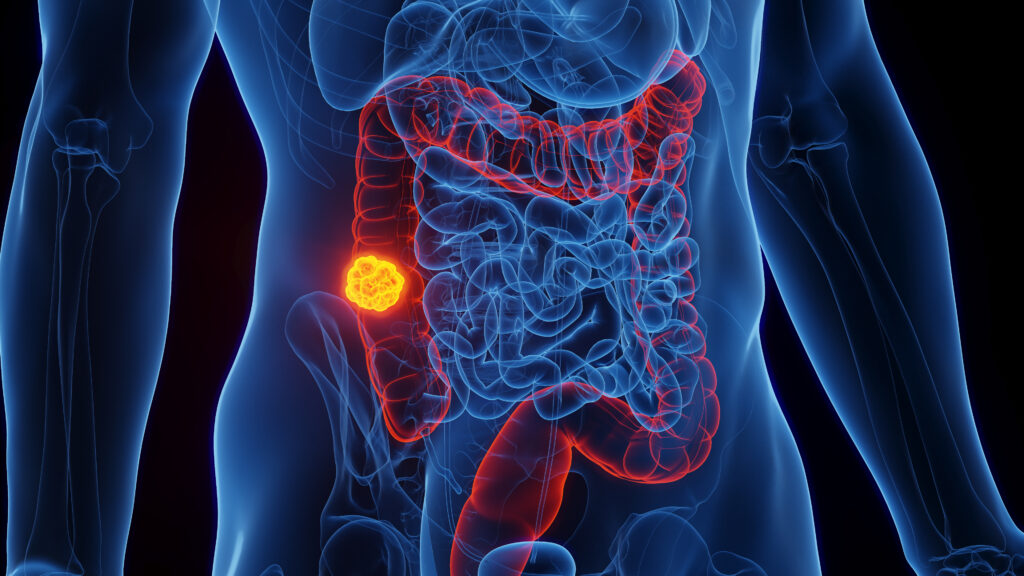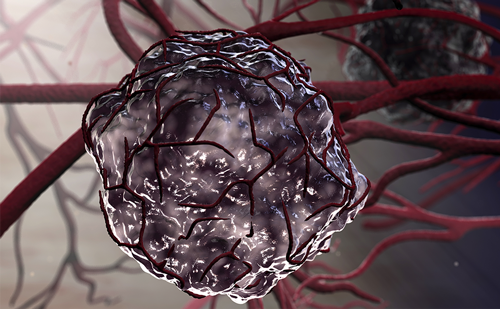TACE has been shown to reduce systemic toxicity and increase local effects and thus improve therapeutic results. There is no generally accepted TACE technique. The core concept includes selective embolisation of tumour-feeding arteries with a chemotherapeutic agent in an emulsion with idodised oil and subsequent embolisation with a particulate agent. The embolising material slows and obstructs intratumoral flow, creating ischaemia and increasing the contact time between the chemotherapeutic agent and the tumour cells, while the iodinated oil produces obstruction of the arterial and portal vein branches through the peribiliary plexus. In addition, tumour cell ischaemia causes tumour cell membrane changes, resulting in intracellular retention of the chemotherapeutic drugs. The chemotherapeutic regime varies considerably between centres, as does the choice of embolisation agent – including non-permanent embolic material such as absorbable gelatine powder or polyvinyl alcohol particles, gelatine-coated tris-acryl embospheres or biocompatible polyvinyl alcohol hydrogels (bead block). Doxorubicin is the most commonly used agent.
The ideal TACE scheme should allow maximum and sustained concentration of chemotherapeutic drugs within the tumour with minimal concentration of the anticancerous drug in peripheral blood combined with tumoral vessel obstruction. DC Bead™ (Biocompatibles UK, Surrey, UK) is a new product specifically designed for TACE. DC Bead microspheres can be loaded with doxorubicin, a chemotherapeutic anthracycline glycolide agent widely accepted for treatment of HCC. This novel device aims for the combined induction of ischaemia and tumour cell lysis, which can be achieved more simply using only one embolising material with certain advantages in pharmacokinetics allowing tumoral vessel obstruction and sustained controlled release of the chemotherapeutic agent locally within the tumour.
In this paper, the use of DC Bead in the treatment of HCC is reviewed, focusing on the unique features of this new technique; comparison with the established methods of TACE is also summarised. Drug-eluting Bead as an Embolic Material
DC Bead is a soft deformable material of spherical shape composed of a polyvinyl alcohol macromer that has been modified with sulphonate groups, as described by Gonsalez et al.7,8 The microspheres are stored in phosphate packing solution and, when admixed with a solution of doxorubicin, the chemotherapeutic agent is incorporated into the bead, which initially increases in size. Upon completion of loading with doxorubicin heparin cofactor I (HCI), the beads undergo a slight decrease in diameter. This diameter reduction allows unobstructed delivery of all sizes of microspheres through microcatheters as small as 2.7F.8
Pre-clinical studies with DC Bead demonstrate a sustained continuous release of doxorubicin for a period of 14 days after injection.7,9 Additionally, pre-clinical and clinical studies have shown that the systemic plasma concentration of doxorubicin was significantly lower than when injected intra-arterially without the DC Bead.9 The rate of elution of doxorubicin at the tumour depends on the osmolality of the tumour and the size of the injected beads (the larger the beads, the slower the local release).8 These correlations were also proved in pre-clinical animal studies9 and in recent studies with pigs.10
The beads present a maximum loading capacity with doxorubicin that reaches 45mg/ml of hydrated beads to maintain the controlled local release and avoid overflow to the systemic circulation.8 Lewis et al. also found that the greater the osmolality of the used solution, the less drug loading is achieved; for this reason, solution preparation instructions should be meticulously maintained.8 Although DC Bead is stable to higher concentrations, the safety and efficacy range is 25–37.5mg/ml of doxorubicin with a maximum recommended life-dose of 450mg/m of body surface area to avoid cardiac toxicity.7,8,12
Increased tumour concentration and low peripheral blood levels are desirable to achieve good results and minimum toxicity. In their recent animal study, Lewis et al. found that higher peripheral concentrations may occur with smaller bead diameters. Pharmacokinetic studies in a Vx-2 animal model showed that plasma concentration of doxorubicin was minimal after embolisation, suggesting tumour retention of the drug compared with control animals treated with doxorubicin intraarterially. 9 Within the tumour, doxorubicin concentration reached a peak at three days post-embolisation and remained high for seven days before declining, which was seen at 14 days. In a recent clinical study using doxorubicin-loaded DC Bead, concentration in the peripheral blood was significantly lower compared with the conventional TACE (p=0.00002).11
These properties of DC Beads are not present in other embolisation materials used in chemoembolisation; as shown in other studies, polyvinyl alcohol particles or the gelatine-coated tris-acryl embospheres do not have the capability to transfer the doxorubicin molecules internally and, in addition, suspensions are unstable.12 In vitro measurements have also shown that when lipiodol was used as a doxorubicin carrier – such as in conventional TACE – local release was very rapid.8 Antitumoral Effects of the Device
Initial in vivo studies in a rabbit Vx-2 model showed that at concentrations per liver weight planned for clinical trials the concentration of doxorubicin in the peripheral blood was low and the fraction of nonviable tumour was higher compared with the intra-arterial injection.7,9 In addition, in the same model Hong et al. found that intra-tumoral doxorubicin levels at 72 hours after embolisation were about 400% higher than those after conventional TACE.9 Imaging and pathological correlations in an animal series with Yucatan pigs in which blunt beads and doxorubicin-eluting beads were compared showed that necrosis was more profound and more severe with the DC Beads.8,10 Tumour necrosis was greatest 7–14 days after treatment, while for this period the combined damaged and necrotic cells approached 100%. Compared with necrosis induced in controls with intra-arterial injection of doxorubicin followed by embolisation with unloaded DC Bead, there was a statistically significant advantage with the loaded beads. In the animal study of Hong et al., tumour necrosis in the Vx-2 animal model approached 100% at seven days, while plasma concentration of doxorubicin was minimal.9
Comparative Results of Transarterial Chemoembolisation and DC Bead
Results of non-DC Bead (conventional) TACE vary significantly between different studies, not only because of the different techniques used, but also because of the lack of homogeneity of patient and tumour samples.
TACE results in the randomised trial conducted by Lo et al. reported one-, two- and three-year survival rates of 57%, 31% and 26%, respectively, compared with 32%, 11% and 3%, respectively, in the control group;4 in the randomised trial of Llovet et al., survival rates at one and two years were 82% and 63%, respectively, compared with 63% and 27%, respectively, with symptomatic treatment.3 The French multicentre trial on patients with advanced HCC showed survival rates with TACE of 64% and 38% at one and two years, respectively, compared with 18% and 6%, respectively, in the untreated control arm.13
Conventional TACE results from previous studies applied in relatively small cancers – which today are mostly directed to radiofrequency catheter ablation (RFA) – report a three-year survival of 34–77%,3–6,14 while in a paper in which TACE was applied prospectively to potential RFA candidates survival was 80%, 43% and 23% at one, three and five years, respectively.15 Local recurrence rates after a single conventional TACE were 33.2% at one year and 33.2% and 37.8% at two and three years, respectively, in the study by Takayasu et al.,14 while survival rates at this study at one, two and three years were 93.3%, 77.1% and 77.1%, respectively, for tumours less than 5cm in diameter. Brown et al. demonstrated 61%, 42% and 32% survival rates at one, two and three years, respectively.16
Cumulatively, TACE achieves a partial response in 15–55% of patients with a delay in tumour progression while systemic doxorubicin provides partial response in 10% of cases without proven survival advantages.3–6,17–19 Llovet et al. reported one- and two-year survival of 82% and 63%, respectively, with objective response sustained for at least six months in 35% of cases3 and a three-year survival of 20–50%.19 Varela et al. in their recent study with doxorubicin-loaded beads in 27 patients with cirrhosis-related HCC and large multifocal HCC observed a response rate of 75% (66.6% on intention-to-treat).11 Oneand two-year survival rates were 92.5% and 88.9%, respectively.11
Malagari et al. in their study of 62 cirrhosis-related HCC patients who underwent sequential embolisations with doxorubicin-loaded DC Bead with an interval of two months between each procedure observed high percentages of tumour necrosis from the first embolisation.20
Objective response according to RECIST was observed in 20.9%, 61.8% and 70.8% across the three procedures. Complete response was observed in 4.8% post-first procedure, rising to 6.7% and 10.1% after the second and third, respectively. Mean tumour necrosis ranged from 77.4% to 83.9% across three treatments. A-Fetoprotein levels showed a mean decrease of 1123ng/ml (95% confidence interval (CI) = 846–1,399, p=3×10–11) post-first session and remained stable after the second and third embolisations (42 and 70ng/ml decrease, respectively).
Liver Function
A common observation in all TACE procedures is a transient rise of liver enzymes peaking at 24–36 hours and returning to baseline after five to six days. Previous studies with DC Bead showed that similar increases also develop with a more prolonged elevation, which may remain high over a 14-day period. This may be attributed to the sustained release of doxorubicin causing a cytotoxic effect.9,10 A more profound transient increase in liver enzymes has been observed in animal studies when small DC Beads were used.10
In their recent study, Varela et al. showed that the treatment was well tolerated without impairment of liver function.11 Likewise, Malagari et al.20 observed transient liver enzyme increase with return to baseline at one month after each procedure. Bilirubin levels remained relatively constant, with no statistically significant changes compared with baseline.
Complications
TACE-related mortality is less than 4%.21 The most common serious adverse events are liver abscess or liver infarction, each of which occur in approximately 2% of patients; 30-day mortality is 1%.3–6,17–19 In the study by Varela et al., two cases of liver abscess were observed out of 27 patients, one of which was lethal.11 In the study by Malagari et al., procedure-related mortality was 0%.20 In this study, all patients suffered from post-embolisation syndrome; the maximum duration of pain was three days. Fever was observed in 83%, 80% and 95% of the patients after the first, second and third procedure, respectively. Serious complications, including liver abscess and cholocystitis, developed in 3.2% of their patients.
Published data show that TACE is an effective method of treatment for HCC. Early clinical results show that doxorubicin-eluting DC Bead presents higher percentages of necrosis and tumour response in shortterm follow-up. Randomised trials of DC Bead TACE and conventional TACE are currently taking place that will provide more solid conclusions.
Long-term follow-up is necessary in order for the existing DC Bead registries to define long-term survival rates, recurrence-free time length and percentage of new lesions occurring in non-embolised areas of the liver.












